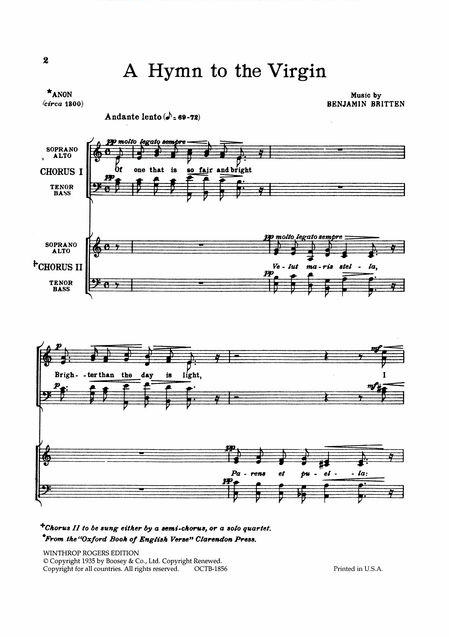
Happy Present Meet
Britten Hymn to the Virgin for SSAATTBB (1930, rev. 1934)
SATB Double Chorus a cappella
Choral (SSAATTBB choir A Cappella)
성부구성 : SSAATTBB
S : Soprano
A : Alto
T : Tenor
B : Bass.
Sacred Choral.
Sacred, Classical, British, Contemporary. Octavo
6.75x10.5 inches.
For unaccompanied SATB with solo or semi-chorus SATB quartet
Difficulty level: 2
Duration: 4 minutes
As young as he was, aged only 16, Britten produced in this carol a tiny masterpiece. This is one of the most well-known and best-loved of his choral pieces. Understandably so, too. It has all the ingredients which make for a really satisfying choral experience.
The use of a solo quartet or small semi-chorus, best placed at a distance, brings a dramatic element to the essential simplicity of the carol.
The Latin responses of the semi-chorus to the medieval English words of the main chorus give these responses a further element of mystery which adds another layer of spiritual drama.
The ratcheting up of the intensity in the final verse by increasing the tempo, by the ATB of the main chorus singing continuous rising phrases and by the sopranos singing a short phrase which is answered by the semi-chorus brings the piece to its climax.
The final tranquillo page leads the carol to its conclusion in a mesmerizingly beautiful final phrase sung by the semi-chorus.
Care needs to be taken with the speed, the semi-chorus placing, and the creation of an atmosphere which demands attention from the listener.
Speed: be careful to note Brittens marking of quaver (1/8th note) = 69-72.
This is very slow indeed.
Try it with a metronome.
Many conductors perform this piece at crotchet (1/4 note) = 69! Frankly, I find the original speed too slow to make this piece flow.
I see that when I recorded this with the Finzi Singers we made a tempo of crotchet = c50. Purists may be dismayed at this wilful ignoring of a composer`s intentions (especially given the strictures outlined in the Preface to this Guide).
I think if I were to re-record this now, I would choose a tempo of about quaver = 88.
Note that for the quicker final verse Britten suggests a crotchet tempo.
This means he did think about the issues of speed very carefully.
Placing: Some choirs choose to put the semi-chorus at the other end of the church, or in a gallery for dramatic effect.
Directors, however, have to remember that while this might work in the first two verses, in the last verse the two groups sing together and have to balance to some degree. Thought should also be given to the fact that if the semi-chorus is placed at the other end of a church behind the audience, the audience sitting near the back will hear them more strongly than the main choir.
It is best to place the semi-chorus behind the choir but still quite close, perhaps by the altar if the main choir is in the choirstalls, or just in front of the altar.
Always make sure that the semi-chorus can see the conductor!
Paul Spicer, Lichfield, 2011
어린 나이에 16 세에 불과했던 Britten은이 캐롤에서 작은 걸작을 작곡했습니다. 이것은 그의 합창곡 중 가장 유명하고 가장 사랑받는 노래 중 하나입니다. 너무 이해할 수 있습니다. 정말 만족스러운 합창 경험을 만들기위한 모든 재료를 가지고 있습니다.
거리에 가장 잘 배치 된 솔로 쿼텟 또는 작은 세미 코러스의 사용은 캐럴의 필수적인 단순성에 극적인 요소를 제공합니다.
메인 코러스의 중세 영어 단어에 대한 세미 코러스의 라틴어 반응은 이러한 반응을 신비의 또 다른 요소로 제공하여 영적인 드라마의 또 다른 층을 추가합니다.
템포를 늘리고, 메인 코러스의 ATB가 계속 상승하는 프레이즈를 부르고 소프라노가 세미 코러스가 대답하는 짧은 프레이즈를 부름으로써 최종 절에서 강도를 높여 가면서 절정을 이끌어냅니다.
마지막 tranquillo 페이지는 세미 합창단이 노래 한 최면술 적으로 아름다운 마지막 구절로 캐롤을 결론지었습니다.
속도, 세미 코러스 배치 및 청취자의주의를 요구하는 분위기 조성과 함께주의를 기울여야합니다.
속도 : 브리튼 (Brittens) 마비 (1 / 8th 음) = 69-72 마킹에주의하십시오.
이것은 실제로 매우 느립니다.
메트로놈으로 시도해보십시오.
많은 지휘자가이 조각을 가위로 연주합니다 (1/4 음표) = 69! 솔직히, 나는 원래의 속도가 너무 느려서이 조각이 흐려지는 것을 발견하지 못한다.
나는 이것을 Finzi Singers와 함께 녹음했을 때 우리는 crotchet = c50의 템포를 만들었다는 것을 알았습니다. 청중들은 의도적으로 작곡가의 의도를 고의적으로 무시하면서 당황 스러울 수 있습니다 (특히이 책의 서문에서 설명 된 제한 조건을 감안할 때).
나는 이것을 지금 다시 녹음한다면, 나는 quaver = 88의 템포를 고를 것이라고 생각한다.
브리튼은 더 빠른 최종 구절을 위해 가락 템포를 제안합니다.
이것은 그가 속도의 문제에 관해 매우 신중하게 생각했다는 것을 의미합니다.
장소 : 일부 합창단은 반 코러스를 교회의 다른 쪽 끝에 두거나 갤러리에 극적인 효과를주기를 선택합니다.
그러나 감독은 이것이 처음 두 구절에서 효과가 있을지 모르지만, 마지막 구절에서 두 그룹이 함께 노래하고 어느 정도 균형을 이루어야한다는 것을 기억해야합니다. 세미 코러스가 관객 뒤에있는 교회의 반대편 끝에 놓여지면 뒤쪽에 앉아있는 청중이 주 합창단보다 더 강하게들을 것이라는 사실에 대해서도 생각해 봐야합니다.
합창단 뒤에 세미 합창을 놓는 것이 가장 좋지만, 여전히 합창단이 초가집에 있거나 제단 바로 앞에있는 경우 제단으로 가깝습니다.
항상 세미 코러스가 지휘자를 볼 수 있는지 확인하십시오!
작곡가 Britten, Benjaming (1913-1976)
